Information on Several Important Parameters of LED Grow Light-PAR/PPF/PPFD/DLI
PAR, photosynthetically active radiaton, is essentially a measure of light intensity within the visible range of 400nm to 700nm that used to drive photosynthesis. note that it is not yet a concretely measureable value like length, distance and weight etc that can make the abstract into the concrete. what it count , photosynthetically active radiation process, is a continuous photon strike flow . if you don't appoint some corresponding fix quantities ,what it expresses is a concept of describing a continuous state and it is difficult to use it to state some certain quantities invisible and intricate that need to be defined in photosynthesis.
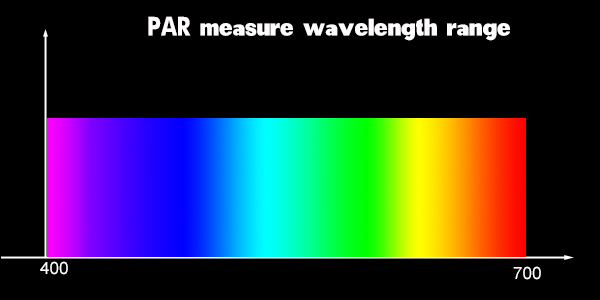
PAR is the amount of light that’s usable to plants- those wavelengths that will be used for photosynthesis. PAR is not the measure of all of the light a grow light gives off, but the measurement of the wavelengths plants will absorb.
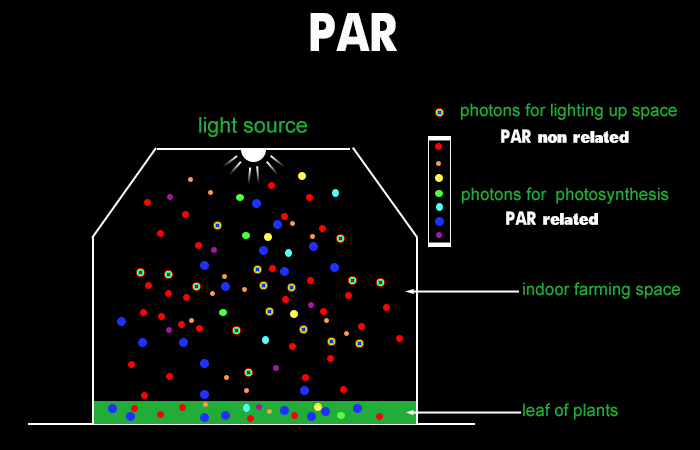
generally , we assume the light of LED grow light system emits in the form of photons . some of photons are used to light up the indoor farming space and the others are catched by plants and take part in the photosynthesis process in the form of energy. see the picture above, light source throw off a variaties of photons . only the photons that plants can use for photosynthesis are related with PAR .
PAR measures light intensity of grow light but actually hasn't told us the quality of the spectrum . before explaining some relationships between PAR and spectrum . we have to form a unified understanding that no matter what the light of nature or artificial light , red light has a longer wavelenght than blue light . but blue light is more energetic than red light . we have assumed that light is constructed of individual light particles associated to energy. as there's a difference in energy between these two lights. when given the same energy supply . the photons red light generates are more than that of the blue light . that is why different colour lights possess different amount photons.
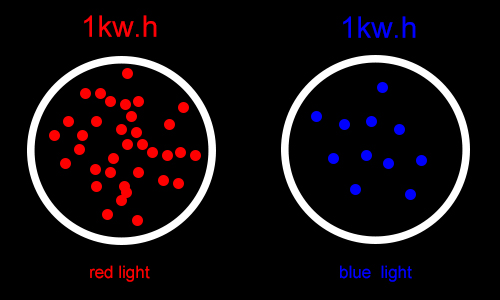
so When comparing the following two spectra. it is easily know that PAR of apectrum B is higher than spectrum A . but is spectrum B must be better than A one ? it is hard to say . in theory , leafy plants prefer to the spectrum A but flowering plants don't, they would be more insterested in spectrum B , especially in their flowering phase. therefore . we can't judge the quality of spectra based on the PAR .
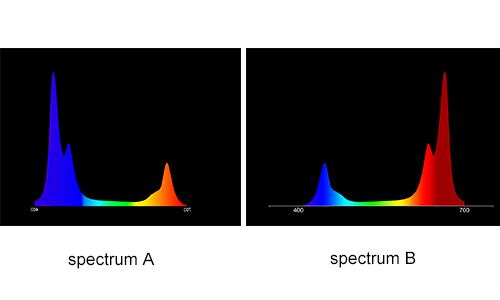
PPF, Photosynthetic Photon Flux , it is used to measure how many photosynthetically active photons (400-700nm) that emit from light source per second. its unit is μmol/s . however , it is with regret that we can't get the information about the total amount photons that really reach the plants and truly are absorbed by plants from this value . strictly speaking , we should take out the PAR non-related photons (that use for lighting up indoor space ) and the photons that not available for photosynthesis before testing the PPF. the existen of these two kinds of photons seriously influence the accuracy of PPF that used to judge the useness of a grow light to plants . hence PPF is still not a conclusive parameter for grow lights.PPF output is not a good indicator of how grow lamps will perform to plants but is a indicator as to the power output .
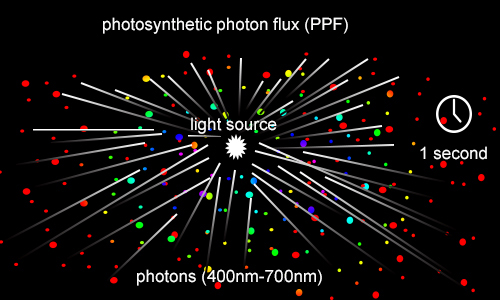
PPFD , photosynthetic photon flux Density, it is used to assess the lighting efficacy of LED grow light. and it is a comparetively important parameter for grow lights. this value points out the number of photosynthetic active photons that fall on a given surface per second . its unit is μmol/㎡.s. see the picture below for further understanding.
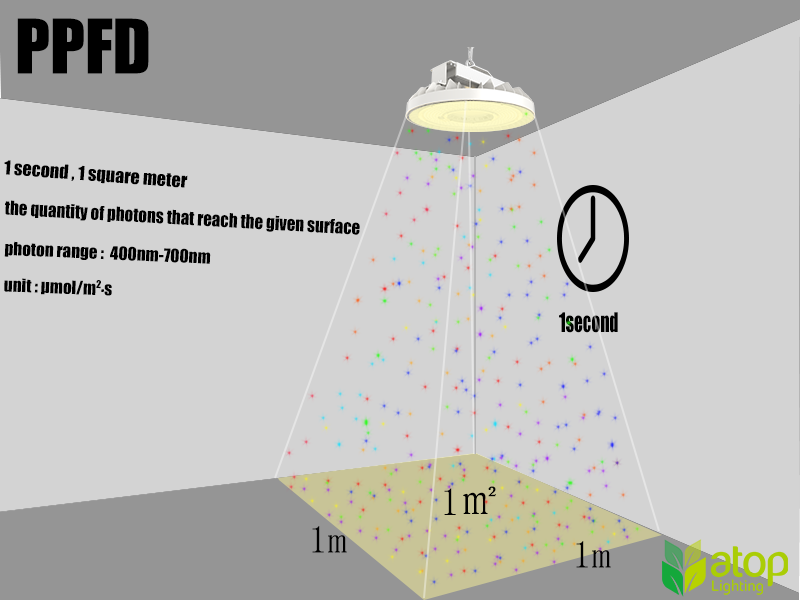
Does high PPFD value mean high lighting efficacy for plants light ? The answer is no . there are commom misunderstandings . if you are not careful enough , you may fall into the trap and choose the wrong products for your growing project, which will lead to failure in achieving your expectant output target.
PPFD is a spot measurement at any point under a light. at the points exactly under the light you will get quite higher numbers. and these numbers will decrease as you move further away from the centre point. some producers will utilize the observed value of center as some gimmicks to show off their agriculture lighting products. so it is necessary to figure out the source of PPFD such as the testing environment and conditions at that time , or at least careful.
Actually what matters is the average PPFD value. so when it come to purchasing led grow lights for practical application , it is essential to ask your supplier to provide you these reference values and read and examine them carefully .
as for the PPFD measure ,It is not exactly accurate to do only one measurement and infer the average PPFD value for the whole cultivation area based only on single measurement. according to the distribution character of light , we know that the divergency of light is uneven
the PPFD graph what you generally see on the information of grow lamps is the result of doing multiple PPFD measurements across the test area make it more accessible .This is a very helpful drawing which tells the rough light distribution on plants. It can be used to compare the performance of different led grow lights from various products on the market.
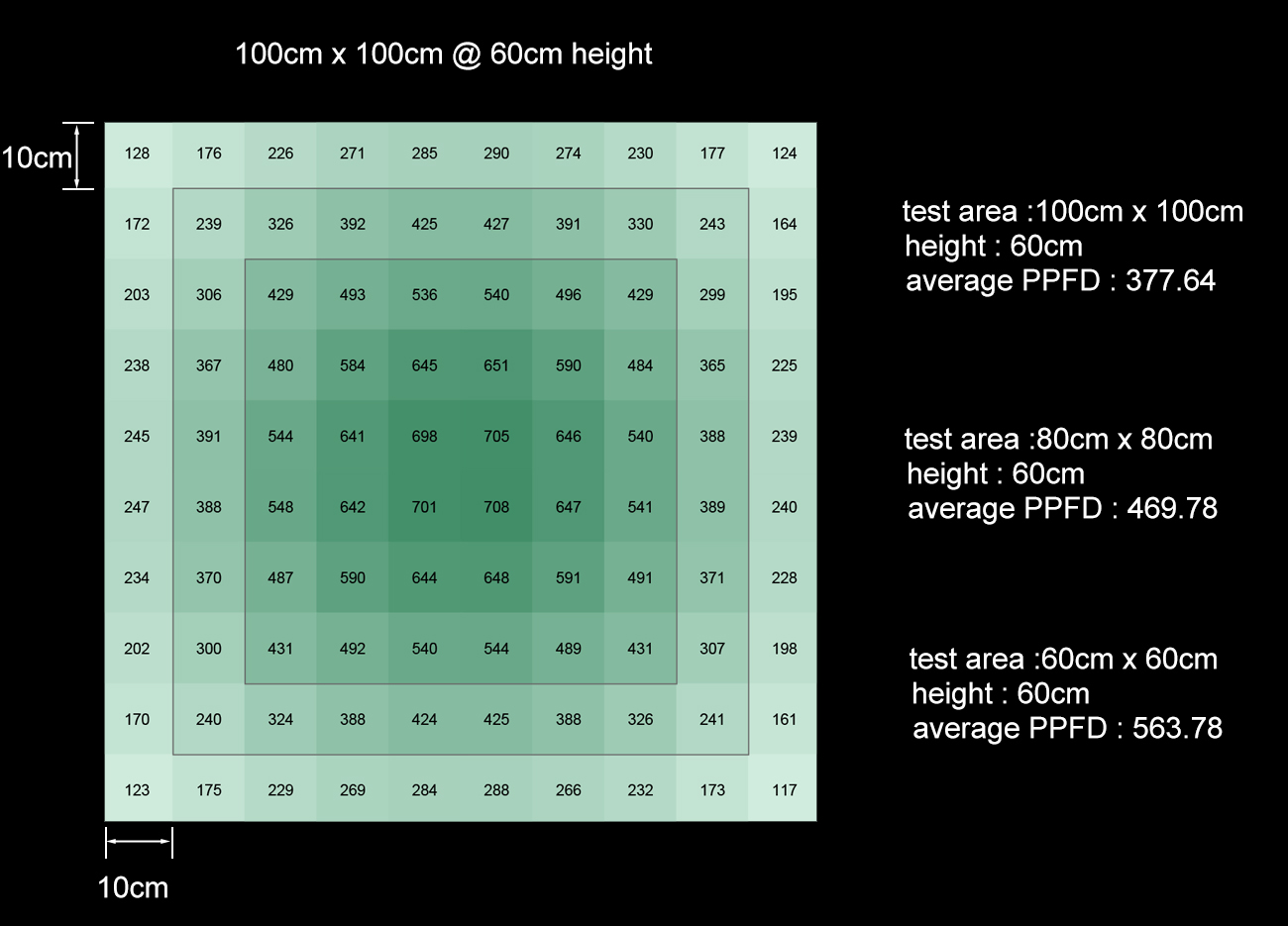
it is also called PAR measurement graph . in the graph above , it shows the the PAR of each point in the given installation height of led grow light and appointed area. through graph like this you can very easily account the average PPFD of each test area . normally , here also will come with several test graphs that test at different heights or designated heights to make the data more rigorous .
it is a shame that this value only calculate the photons of the light range 400nm-700nm . however , there are many grow light spectra provided by LED grow light companies beyond that scope .
DLI, daily light integral, refers to the total photosynthetically active photons plants absorbing every day . it is a significative parameter for led grow lights , measured in mol/㎡.day or mol/㎡/d.for plants,more isn't always better.
Photosynthesis involves two biochemical processes, known as light reaction and dark reaction. During light reaction, the plant absorbs light and turns it into energy. This energy is in an unstable situation, however, and cannot be stored for later use. To solve this problem, the plant's dark reaction converts these energy compounds into carbohydrates, which can be stored and accessed later. although we know dark reaction can happen at any time , regardless of whether there is light or not. there are still some plants sensitive to light and need a certain amount of darkness to .otherwise , if exposed to light 24 hours a day. some plants may remain healthy, others may keep in the state of surviving but not thriving .

